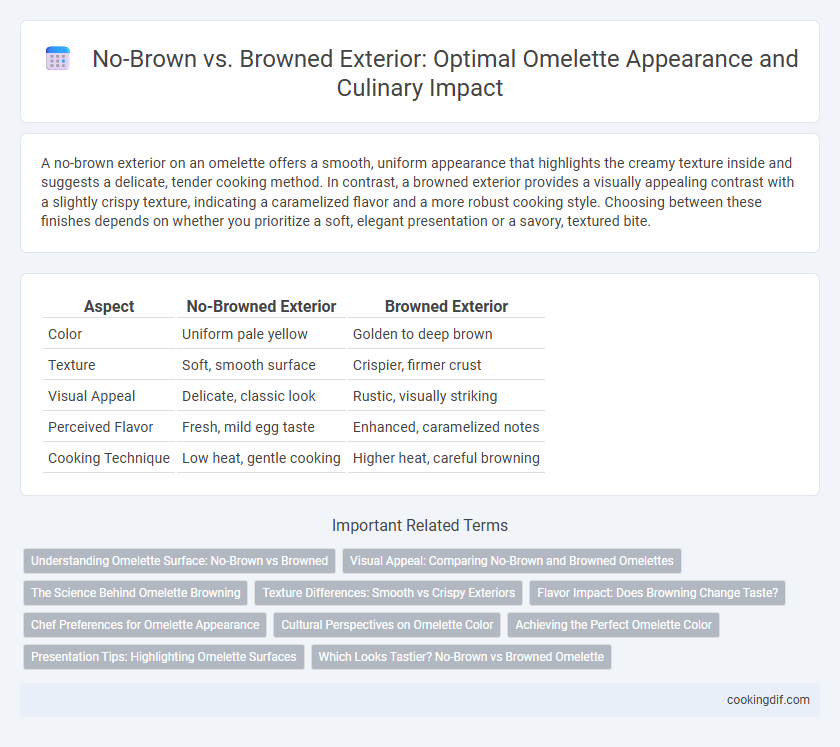A no-brown exterior on an omelette offers a smooth, uniform appearance that highlights the creamy texture inside and suggests a delicate, tender cooking method. In contrast, a browned exterior provides a visually appealing contrast with a slightly crispy texture, indicating a caramelized flavor and a more robust cooking style. Choosing between these finishes depends on whether you prioritize a soft, elegant presentation or a savory, textured bite.
Table of Comparison
| Aspect | No-Browned Exterior | Browned Exterior |
|---|---|---|
| Color | Uniform pale yellow | Golden to deep brown |
| Texture | Soft, smooth surface | Crispier, firmer crust |
| Visual Appeal | Delicate, classic look | Rustic, visually striking |
| Perceived Flavor | Fresh, mild egg taste | Enhanced, caramelized notes |
| Cooking Technique | Low heat, gentle cooking | Higher heat, careful browning |
Understanding Omelette Surface: No-Brown vs Browned
An omelette's surface appearance varies significantly between no-brown and browned exteriors, reflecting different cooking techniques and flavor profiles. No-brown omelettes maintain a soft, pale surface highlighting a gentle heat application, preserving moisture and tenderness. In contrast, browned exteriors result from higher heat and Maillard reactions, creating a golden crust that enhances texture and adds a rich, nutty flavor complexity.
Visual Appeal: Comparing No-Brown and Browned Omelettes
No-brown omelettes feature a smooth, pale yellow surface that emphasizes a soft and tender texture, creating a delicate and fresh visual impression. Browned omelettes showcase a golden to deep amber exterior with slight caramelization, adding a crispy texture and appealing contrast that signals rich flavor development. The visual appeal of no-brown versus browned omelettes depends on presentation preferences, where the former highlights purity and freshness while the latter evokes warmth and enhanced taste through Maillard reaction colors.
The Science Behind Omelette Browning
Omelette browning occurs due to the Maillard reaction, a chemical process where amino acids and reducing sugars react under heat, creating complex flavors and a golden-brown color. No-brown omelettes retain a pale, tender texture by cooking at lower temperatures to avoid this reaction, preserving delicate egg proteins and moisture. Browned exteriors develop at higher heat, enhancing taste and texture through caramelization and protein denaturation, but may risk a firmer or slightly crispy surface.
Texture Differences: Smooth vs Crispy Exteriors
A no-brown omelette features a smooth, tender exterior with a delicate texture that highlights the creamy interior, while a browned omelette offers a crispy, slightly caramelized surface that adds a satisfying crunch. The smooth exterior results from gentle, low-heat cooking that preserves moisture, whereas the browned surface develops through higher heat or longer cooking time, promoting Maillard reaction for enhanced flavor and texture contrast. Texture differences significantly alter the eating experience, with the no-brown omelette emphasizing softness and the browned version providing a dynamic crispy bite.
Flavor Impact: Does Browning Change Taste?
A no-brown omelette maintains a tender texture and mild egg flavor, preserving subtle ingredient nuances without the Maillard reaction's influence. A browned exterior enhances flavor complexity by introducing caramelized, savory notes and a slightly crisp texture, which can deepen the overall taste experience. The choice between no-brown and browned surfaces ultimately affects umami intensity and mouthfeel, shaping personal preference for omelette flavor profiles.
Chef Preferences for Omelette Appearance
Chefs often prefer a no-brown omelette exterior for a soft, tender texture that showcases a delicate, uniform appearance ideal for sophisticated presentations. A browned exterior offers a contrasting texture with slightly crisp edges, adding visual depth and a robust flavor profile favored in rustic or hearty dishes. The choice depends on culinary style, with French chefs typically favoring the smooth, pale finish, while American or diner-style cooks embrace the browned, golden look for added character.
Cultural Perspectives on Omelette Color
Omelette appearance varies significantly across cultures, with some valuing a no-brown, pale exterior as a sign of tenderness and freshness, commonly preferred in French cuisine where a soft, smooth texture is prized. In contrast, many Asian and American styles embrace a browned exterior, emphasizing Maillard reaction flavors and a slightly crispy texture that signals richness and enhanced taste complexity. These differing preferences reflect broader cultural tastes and culinary techniques, influencing how omelettes are perceived and enjoyed globally.
Achieving the Perfect Omelette Color
Achieving the perfect omelette color hinges on controlling heat and cooking time to balance a golden-brown exterior with a tender interior. A no-brown omelette boasts a smooth, pale surface favored for delicate presentations, while a browned exterior signals Maillard reaction development, enhancing flavor and texture. Mastery of temperature and pan type, such as using non-stick or stainless steel skillets, is essential for consistent omelette appearance without unwanted browning or undercooking.
Presentation Tips: Highlighting Omelette Surfaces
A no-brown exterior on an omelette ensures a smooth, vibrant yellow surface, ideal for presentations emphasizing freshness and a delicate texture. Achieving a browned exterior adds a golden, slightly crisp layer that enhances flavor and visual appeal with a contrast of textures. Presentation tips include gently cooking over medium-low heat to avoid unwanted browning or purposely increasing heat slightly for a toasted effect, then garnishing with fresh herbs to highlight surface differences.
Which Looks Tastier? No-Brown vs Browned Omelette
A browned exterior on an omelette often signals a richly caramelized flavor and a crispy texture that many find more visually appetizing and indicative of a well-cooked dish. In contrast, a no-brown omelette presents a softer, smoother surface, appealing to those who prefer a delicate, tender bite without the intensity of char. Consumer preference tends to favor the browned look for its enhanced taste perception and rustic appearance.
No-Brown vs Browned Exterior for omelette appearance Infographic

 cookingdif.com
cookingdif.com